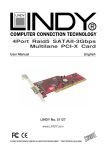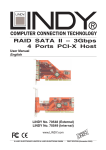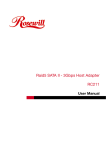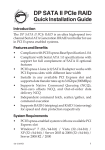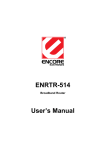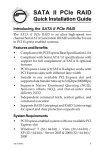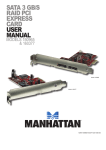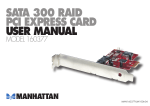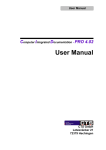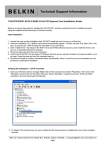Download Addonics ADS3GX4R5-E
Transcript
Addonics T E C H N O L O G I E S 4-Port External SATA II PCI/PCI-X RAID5 Controller Card (ADS3GX4R5-E) User’s Guide Revision 1.2 FCC Warning Statement This equipment has been tested and found to comply with the limits for a Class B digital device pursuant to Part 15 of the FCC rules. These limits are designed to provide reasonable protection against harmful interference in a residential installation. This equipment generates, uses and can radiate radio frequency energy. If not installed and used in accordance with the instructions, it may cause harmful interference to radio communications. However, there is no guarantee that interference will not occur in a particular installation. If the equipment does cause harmful interference to radio or television reception, which can be determined by turning the equipment on and off, the user is encouraged to try and correct the interference by one or more of the following suggestions. Reorient or relocate the receiving antenna Increase the distance between the equipment and the receiver Connect the equipment to a different power outlet other than the one where receiver is connected Consult a certified television or radio technician LIMITED WARRANTY Addonics guarantees that every product is free from physical defects in material and workmanship during the warranty period specified for each product when used within the limits set forth in the Specifications section in the user guide. Unauthorized temperin g of the product or using it outside the scope of the product specifications will result in voiding the warranty. If the product proves defective during this warranty period, call Addonics Technical Support to obtain a Return Authorization number. BE SURE TO HAVE YOUR PROOF OF PURCHASE ON HAND WHEN CALLING. RETURN REQUESTS CANNOT BE PROCESSED WITHOUT PROOF OF PURCHASE. When returning a product, mark the Return Authorization number clearly on the outside of the package and include your original proof of purchase. Customers are responsible for paying the shipping and handling of the products to Addonics warranty service location. IN NO EVENT SHALL ADDONICS’ LIABILITY EXCEED THE PRICE PAID FOR THE PRODUCT FROM DIRECT, INDIRECT, SPECIAL, INCIDENTAL, OR CONSEQUENTIAL DAMAGES RESULTING FROM THE USE OF THE PRODUCT, ITS ACCOMPANYING SOFTWARE, OR ITS DOCUMENTATION. Addonics makes no warranty or representation, expressed, implied, or statuary, with respect to its products or the contents or use of the user guide and all accompanying software, and specifically disclaims its quality, performance, merchantability, or fitness for any particular purpose. Addonics reserves the right to revise or update its products, software, or documentation without obligation to notify any individual or entity. Addonics Technologies Users Guide v1.0 4-Port eSATA II PCI/PCI-X RAID5 Controller Card 1 Contents FCC Warning................................................................................... 1 LIMITED WARRANTY ................................................................. 1 Contents............................................................................................ 2 Chapter 1 Specifications ................................................................... 3 Chapter 2 RAID Tutorial ............................................................... 4-5 Chapter 3 BIOS Installation .......................................................... 6-7 Chapter 4 New Windows System (fresh installation).................... 8-11 Chapter 5 Existing Windows System Installation....................... 13-18 Windows 2000 Driver ............................................... 13-14 Windows XP Driver .................................................. 15-16 Windows 2003 Server .............................................. 17-18 Verifying controller driver.............................................. 18 Chapter 6 Existing Macintosh System Installation ..................... 19-21 Technical Support & Contact Information .................................... …22 Addonics Technologies Users Guide v1.0 4-Port eSATA II PCI/PCI-X RAID5 Controller Card 2 Chapter 1 Specifications General = Serial ATA (SATA) – 3.0 Gbps (300MB/s) or 1.5 Gbps (150MB/s) = Compliant with SATA 1.0, and ATA, ATA II Extensions to SATA 1.0: • Port Multiplier • Native Command Queuing (NCQ) • First Party DMA = Four independent DMA channels with 2KB FIFO per channel = Independent command fetch, scatter/gather, and command execution =Supports up to 4MB External FLASH =Supports ATAPI devices: CD-ROM, DVD-ROM, etc. =Supports hot-plug of SATA devices =Built-in RAID 0, RAID 1, RAID 1+0, RAID 5 and JBOD support =Silicon Image chipset SiI 3124 PCI-X Interface =64-bit 133MHz PCI-X =Backward compatible with PCI v2.3 Addonics Technologies Users Guide v1.0 4-Port eSATA II PCI/PCI-X RAID5 Controller Card 3 Chapter 2 RAID tutorial 2. What is RAID? RAID - Redundant Array of Independent Disks RAID technology manages multiple disk drives to enhance I/O performance and provide redundancy in order to withstand th e failure of any individual member, without loss of data. This card provides two RAID Set types, Striped (RAID 0) and Mirrored (RAID 1). 2.1 Disk Striping (RAID 0) Striping is a performance-oriented, non-redundant data mapping technique. While Striping is discussed as a RAID Set type, it is actually does not provide fault tolerance. With modern SATA bus mastering t echnology, multiple I/O operations can be done in parallel, enhancing performance. Striping arrays use multiple disks to form a larger virtual disk. 2.2 Disk Mirroring (RAID 1) Disk mirroring creates an identical twin for a selected disk by having the data simultaneously written to two disks. This redundancy provides instantaneous protection from a single disk failure. If a read failure occurs on one drive, the system reads the data from the other drive. 2.3 Mirrored-Striping (RAID 1+0) A Mirrored-Striping Set does just what it says, combining both Striping and Mirroring technologies to provide both the performance enhancements that come from Striping and the data availability and integrity that comes from Mirroring. When data is written to a Mirrored-Striped Set, instead of creating just one virtual disk, as Striping would do, a second, mirrored virtual disk is created as well. 2.4 Spare Drive (RAID 1 +S) Spare Drive is a standby drive assigned to serve a Raid 1 Set. When a member drive of this Raid 1 set drive fails, the Spare Drive becomes a member drive and automatically starts to rebuild. Thus making it the new member of the Raid 1Set. Addonics Technologies Users Guide v1.0 4-Port eSATA II PCI/PCI-X RAID5 Controller Card 4 2.5 Parity RAID (RAID 5) Parity or RAID 5 adds fault tolerance to Disk Striping by including parity information with the data. Parity RAID dedicates the equivalent of one disk for storing parity stripes. The data and parity information is arranged on the disk array so that the parity is written to different disk. There are at least 3 members to a Parity RAID set. 2.6 JBOD (Just Bunch of Disks) The JBOD is a virtual disk that can either be an entire disk drive or a segment of a single disk drive. Addonics Technologies Users Guide v1.0 4-Port eSATA II PCI/PCI-X RAID5 Controller Card 5 Chapter 3 BIOS Installation (RAID Setting) Creating and deleting RAID sets is a function found in the BIOS. During boot up, the RAID setting message will appear and pause for a few moments to allow the user to choose what to do. This board will act as normal NON-RAID card when BIOS not configured for RAID. Just proceed to Software Installation section directly. If you use traditional parallel ATA HDD, make sure your hard drives be set up as master mode before the RAID setting. 3.1 Creating Striped Sets (RAID 0) 1. As the BIOS boots, Press CTRL+S or F4 to enter the raid bios utility. 2. Select Create RAID set. Press Enter. 3. Select Stripe then press Enter. 4. Select Auto configuration or manually select the drives Press Enter. 5. Press Y to save your settings. 6. Press CTRL+E and then press Y to exit the setup. 7. Your RAID configuration is complete. Please proceed to software installation section. 3.2 Creating Mirrored Sets (RAID 1) 1. As the BIOS boots, Press CTRL+S or F4 to enter the raid bios utility. 2. Select Create RAID set. Press Enter. 3. Select Mirrored then press Enter. 4. Select Auto configuration or manually select the drives. Press Enter. 5. Press Y to save your settings. 6. Press CTRL+E and then press Y to exit the setup. 7. Your RAID configuration is complete. Please proceed to software installation section. 3.3 Creating a Mirrored-Striped Set (RAID 1+0) 1. As the BIOS boots, press CTRL+S or F4 to enter the raid bios utility. 2. Select Create RAID set. Press Enter. 3. Select RAID 1 set then press Enter. 4. Select Auto configuration or manually select the drives. Press Enter. 5. After the Raid 1 set is created then click on Create Raid Set again. 6. Press Create the spare drive. Select the drive to be the spare. 7. Press Y to save your settings. 8. Press Ctrl-E then Y to exit the setup. 9. Your RAID configuration is complete. Please proceed to software installation section. Addonics Technologies Users Guide v1.0 4-Port eSATA II PCI/PCI-X RAID5 Controller Card 6 3.4 Creating a Spare Drive 1. As the BIOS boots, press CTRL+S or F4 to enter the raid bios utility. 2. Select Create RAID set. Press Enter. 3. Select RAID 1 set then press Enter. 4. Select Auto configuration or manually select the drives. Press Enter. 5. After the Raid 1 set is created then click on Create Raid Set again. 6. Press Create the spare drive. Select the drive to be the spare. 7. Press Y to save your settings. 8. Press Ctrl-E then Y to exit the setup. 9. Your RAID configuration is complete. Please proceed to software installation section. Note: Raid 1 must be created first before spare drive can be created. 3.5 Deleting RAID Sets 1. As the BIOS boots, Press CTRL+S or F4 to enter the raid bios utility. 2. Select Delete RAID set. Press Enter. 3. Answer Y to remove the RAID set. If the RAID set being deleted is a Striped set, then all of the data will be lost. If the set being deleted is a Mirrored set, then the data will remain intact and accessible on both drives. 3.6 Rebuilding Mirrored Sets 1. After replacing the failed hard drives boot the BIOS, Press CTRL+S or F4 to enter the raid bios utility. 2. Select rebuilding Mirrored set. Press Enter. 3. Select Online rebuild or Offline rebuild. 4. Answer Y to rebuild the Mirrored set of hard drive. 3.7 Resolving Conflict When a RAID set is created, the metadata written to the disk includes drive connection information (Primary and Secondary). If, after a disk failure, the replacement disk was previously part of a RAID set (or used in another system), it may have conflictin g metada ta, specifically in reference to the dr ive connection information. If so, this will prohi bit the RAID set from being either created or rebuilt, In order for the RAID set to function properly, this old metadata must be first overwritten with the new metadata. To resolve this, select Resolve Conflicts, and the correct metadata, including the correct drive connection information; will be written to the replacement disk. Addonics Technologies Users Guide v1.0 4-Port eSATA II PCI/PCI-X RAID5 Controller Card 7 Chapter 4 New Windows Systems (Fresh Installation) Hardware Configuration Port 1 Note: To do a fresh install of Windows, your hard drive must be connected to Port 1 of the host controller. For New Windows Systems (Fresh Installation) with Port Multiplier Hardware Configuration Port 1 Note: To do a fresh install of Windows, your hard drive must be connected to Port 1 of the Port Multiplier. The eSATA cable coming out of your Port Multiplier must be connected to the eSATA Port 1 of the host controller. Addonics Technologies Users Guide v1.0 4-Port eSATA II PCI/PCI-X RAID5 Controller Card 8 Before installation, extract the driver files to a floppy diskette. a. Open the Addonics Technologies Driver Disk. b. On the main menu select SATA Controller Drivers > ADS3GX4R5-E. c. The Winzip Self-Extractor – ADS3GX45R-E opens. Click Browse and select My Documents. d. The folder ADS3GX4R5-E will be created. e. Select the folder with your corresponding operating system and extract the file to the floppy diskette. Hardware Installations: 1. Remove PC cover. 2. Select an empty PCI/PCI-X slot and insert the SATA Controller. 3. Makes sure to secure the bracket with a screw. 4. Close the PC’s cover. Fresh Windows Operating System Installation Types: A. Concatenated Raid Set Requires One hard drive B. Stripped Raid Set (RAID 0) Requires Two hard drives C. Mirrored Raid Set (RAID 1) Requires Two hard drives D. Parity Raid Set (RAID 5) Requires Three or more hard drives A. CONCATENATED RAID Set Configuration in RAID BIOS: 1. Power ON your PC. 2. Wait until the system prompts for the RAID BIOS Configuration Utility. Press CTRL+ S or the F4 key to enter the BIOS RAID Utility. 3. The RAID Utility menu screen will be displayed. Select Create RAID set. 4. Choose CONCATENATION. Press Enter. Press Enter to select first drive of the RAID set. 5. Are You Sure? Press Y. 6. Under the Logical Drive Component, you should see SiI Concatenation and the Drive Capacity. 7. Press CRTL+E to Exit. 8. Are you sure to exit? Press Y. 9. The PC will reboot. 10. At the Windows Set-up screen, press F6 to specify and add the driver. Addonics Technologies Users Guide v1.0 4-Port eSATA II PCI/PCI-X RAID5 Controller Card 9 11. Insert the Floppy Driver diskette containing the driver from step 1 above. Press S, then press Enter. 12. Select Silicon Image SiI 3124 SATARaid Controller for Windows XP/ Server 2003 or Silicon Image SiI 3124 SATARaid Controller for Windows 2000, press Enter. 13. Press Enter to continue and follow on-screen instructions to complete installation. B. STRIPPED RAID Set Configuration in RAID BIOS: 1. Power ON your PC. 2. Wait until the system prompts for the RAID BIOS Configuration Utility. Press CTRL+ S or the F4 key to enter the BIOS RAID Utility. 3. The RAID Utility menu screen will be displayed. Select Create RAID set. 4. Choose RAID 0. Press Enter. Press Enter to automatically create RAID set. 5. Press Enter to select the Raid size. 6. Are You Sure? Press Y. 7. Under the Logical Drive Component, you should see SiI Raid0 Set and the Drive Capacity. 8. Press CRTL+E to Exit. 9. Are you sure to exit? Press Y. 10. The PC will reboot. 11. At the Windows Set-up screen, press F6 to specify and add the driver. 12. Insert the Floppy Driver diskette containing the driver from step 1 above. Press S, then press Enter. 13. Select Silicon Image SiI 3124 SATARaid Controller for Windows XP/ Server 2003 or Silicon Image SiI 3124 SATARaid Controller for Windows 2000, press Enter. 14. Press Enter to continue and follow on-screen instructions to complete installation. C. MIRRORED RAID Set Configuration in RAID BIOS: 1. Power ON your PC. 2. Wait until the system prompts for the RAID BIOS Configuration Utility. Press CTRL+ S or the F4 key to enter the BIOS RAID Utility. Addonics Technologies Users Guide v1.0 4-Port eSATA II PCI/PCI-X RAID5 Controller Card 10 3. 4. 5. 6. 7. 8. 9. 10. 11. 12. 13. 14. The RAID Utility menu screen will be displayed. Select Create RAID set. Choose RAID 1. Press Enter. Press Enter to automatically create a RAID 1 set without data copy. Press Enter to select the Raid size. Are You Sure? Press Y. Under the Logical Drive Component, you should see SiI Raid1 Set and the Drive Capacity. Press CRTL+E to Exit. Are you sure to exit? Press Y. The PC will reboot. At the Windows Set-up screen, press F6 to specify and add the driver. Insert the Floppy Driver diskette containing the driver from step 1 above. Press S, then press Enter. Select Silicon Image SiI 3124 SATARaid Controller for Windows XP/ Server 2003 or Silicon Image SiI 3124 SATARaid Controller for Windows 2000, press Enter. Press Enter to continue and follow on-screen instructions to complete installation. D. PARITY RAID Set Configuration in RAID BIOS: 1. Power ON your PC. 2. Wait until the system prompts for the RAID BIOS Configuration Utility. Press CTRL+ S or the F4 key to enter the BIOS RAID Utility. 3. The RAID Utility menu screen will be displayed. Select Create RAID set. 4. Choose RAID 5. Press Enter. 5. Select how many drives for the raid set. Press Enter to select 3. 6. Press Enter to automatically create raid set. 7. Press Enter to select the Raid size. 8. Are You Sure? Press Y. 9. Under the Logical Drive Component, you should see SiI Raid5 Set and the Drive Capacity. 10. Press CRTL+E to Exit. 11. Are you sure to exit? Press Y. 12. The PC will reboot. 13. At the Windows Set-up screen, press F6 to specify and add the driver. 14. Insert the Floppy Driver diskette containing the driver from step 1 above. Press S, then press Enter. Addonics Technologies Users Guide v1.0 4-Port eSATA II PCI/PCI-X RAID5 Controller Card 11 15. Select Silicon Image SiI 3124 SATARaid Controller for Windows XP/ Server 2003 or Silicon Image SiI 3124 SATARaid Controller for Windows 2000, press Enter. 16. Press Enter to continue and follow on-screen instructions to complete installation. Addonics Technologies Users Guide v1.0 4-Port eSATA II PCI/PCI-X RAID5 Controller Card 12 Chapter 5 Existing Windows System installation This section provides the information on how to install the drivers of RAID Native SATA-150 4Ports PCI Host Adapter onto computer with existing operating systems: 5.1. Windows 2000 Driver and software installation For Existing Windows 2000 Systems (with Service Pack 2 or later) Note: Install the SATA Utilities from the CD that came with your package first before installing the Host Controller. 1. 2. 3. 4. Power on the system. Insert the CDROM that came with the product. The Addonics Technologies Driver Disk window pops up. Select SATA Utilities > Model # ADS3GX4R5-E. The WinZip Self-Extractor – SiI_3124.exe window pops up. Click the Browse button and locate My Documents, click OK. Click the Unzip button. Go to My Documents, double click the SiI 3124 folder and select the SATARAID Tools folder. Select the folder with your operating system. Install the SATARAID5 software by clicking the 3124-W-I32-R. a. Welcome to the 3124-W-I32-R SATARAID5 Setup Wizard: Click Next. b. License Agreement: Select ‘I Agree’, click Next. c. Do you want to add a shortcut to your Desktop? : Click Next. d. Select Installation Folder: Click Next. e. Confirm Installation: Click Next. f. The J2SE Runtime Environment 5.0 Update 5 – License window opens. Select ‘I accept the terms in the license agreement’ then click Next. g. J2SE Runtime Environment 5.0 Update 5 – Setup Type: Click Next. h. J2SE Runtime Environment 5.0 Update 5 – Complete: Click Finish. i. 3124-W-I32-R-SATARAID5 – Installation Complete: Click Close. Addonics Technologies Users Guide v1.0 4-Port eSATA II PCI/PCI-X RAID5 Controller Card 13 Hardware Installations: 5. Power OFF PC and remove its cover. 6. Select an empty PCI/PCI-X slot and insert the SATA Controller. 7. Makes sure to secure the bracket with a screw. 8. Close the PC’s cover. Windows 2000 Driver Installations 9. Turn computer ON. When Windows boots up, “Found New Hardware Wizard” pops on the screen. The Digital Signature Not Found window opens. The Silicon Image SiI 3124 SoftRaid5 Controller is identified. Do you want to continue the installation? Click Yes. 10. Please wait while the wizard installs the software… 11. When the new hardware wizard has finished installing the Serial ATA Controller Card, click Finish to complete the installations. 12. The “Found New Hardware Wizard” pops on the screen and the Silicon Image’s Pseudo Processor Device is identified. Do you want to continue the installation? Click Yes. 13. Please wait while the wizard installs the software… 14. When the new hardware wizard has finished installing the Silicon Image’s Pseudo Processor Device, click Finish to complete the installations. 15. Restart the PC for the new settings to take effect. Addonics Technologies Users Guide v1.0 4-Port eSATA II PCI/PCI-X RAID5 Controller Card 14 5.2. Windows XP Driver and Software Installation Note: Install the SATA Utilities from the CD that came with your package first before installing the Host Controller. 1. 2. 3. 4. Power on the system. Insert the CDROM that came with the product. The Addonics Technologies Driver Disk window pops up. Select SATA Utilities > Model # ADS3GX4R5-E. The WinZip Self-Extractor – SiI_3124.exe window pops up. Click the Browse button and locate My Documents, click OK. Click the Unzip button. Go to My Documents, double click the SiI 3124 folder and select the SATARAID Tools folder. Select the folder with your operating system. Install the SATARAID5 software by clicking the 3124-W-I32-R. a. Welcome to the 3124-W-I32-R SATARAID5 Setup Wizard: Click Next. b. License Agreement: Select ‘I Agree’, click Next. c. Do you want to add a shortcut to your Desktop? : Click Next. d. Select Installation Folder: Click Next. e. Confirm Installation: Click Next. f. The J2SE Runtime Environment 5.0 Update 5 – License window opens. Select ‘I accept the terms in the license agreement’ then click Next. g. J2SE Runtime Environment 5.0 Update 5 – Setup Type: Click Next. h. J2SE Runtime Environment 5.0 Update 5 – Complete: Click Finish. i. 3124-W-I32-R-SATARAID5 – Installation Complete: Click Close. Hardware Installations: 5. Power OFF PC and remove its cover. 6. Select an empty PCI/PCI-X slot and insert the SATA Controller. 7. Makes sure to secure the bracket with a screw. 8. Close the PC’s cover. Windows XP Driver Installations 9. Turn computer ON. When Windows boots up, “Found New Hardware Wizard” pops on the screen and the Silicon Image SiI 3124 SoftRaid5 Controller is identified. What do you want the wizard to do? “Install the software automatically (Recommended)” is selected by default. Click Next. 10. Please wait while the wizard installs the software… 11. The Hardware Installation window opens. Click “Continue Anyway”. Addonics Technologies Users Guide v1.0 4-Port eSATA II PCI/PCI-X RAID5 Controller Card 15 12. When the new hardware wizard has finished installing the Serial ATA Controller Card, click Finish to complete the installations. 13. The “Found New Hardware Wizard” pops on the screen and the Silicon Image’s Pseudo Processor Device is identified. What do you want the wizard to do? “Install the software automatically (Recommended)” is selected by default. Click Next. 14. Please wait while the wizard installs the software… 15. When the new hardware wizard has finished installing the Silicon Image’s Pseudo Processor Device, click Finish to complete the installations. 16. Restart the PC for the new settings to take effect. Addonics Technologies Users Guide v1.0 4-Port eSATA II PCI/PCI-X RAID5 Controller Card 16 5.3. Windows 2003 Server Driver and software installation Note: Install the SATA Utilities from the CD that came with your package first before installing the Host Controller. 1. Power on the system. Insert the CDROM that came with the product. The Addonics Technologies Driver Disk window pops up. Select SATA Utilities > Model # ADS3GX4R5-E 2. The WinZip Self-Extractor – SiI_3124.exe window pops up. Click the Browse button and locate My Documents, click OK. Click the Unzip button. 3. Go to My Documents, double click the SiI 3124 folder and select the SATARAID Tools folder. Select the folder with your operating system. 4. Install the SATARAID5 software by clicking the 3124-W-I32-R. a. Welcome to the 3124-W-I32-R SATARAID5 Setup Wizard: Click Next. b. License Agreement: Select ‘I Agree’, click Next. c. Do you want to add a shortcut to your Desktop? : Click Next. d. Select Installation Folder: Click Next. e. Confirm Installation: Click Next. f. The J2SE Runtime Environment 5.0 Update 5 – License window opens. Select ‘I accept the terms in the license agreement’ then click Next. g. J2SE Runtime Environment 5.0 Update 5 – Setup Type: Click Next. h. J2SE Runtime Environment 5.0 Update 5 – Complete: Click Finish. i. 3124-W-I32-R-SATARAID5 – Installation Complete: Click Close. Hardware Installations: 5. Power OFF PC and remove its cover. 6. Select an empty PCI/PCI-X slot and insert the SATA Controller. 7. Makes sure to secure the bracket with a screw. 8. Close the PC’s cover. Windows 2003 Server Driver Installations 9. Turn computer ON. When Windows boots up, “Found New Hardware Wizard” pops on the screen and the Silicon Image SiI 3124 SoftRaid5 Controller is identified. What do you want the wizard to do? “Install the software automatically (Recommended)” is selected by default. Click Next. Addonics Technologies Users Guide v1.0 4-Port eSATA II PCI/PCI-X RAID5 Controller Card 17 10. Please wait while the wizard installs the software… 11. The Hardware Installation window opens. Click “Continue Anyway”. 12. When the new hardware wizard has finished installing the Serial ATA Controller Card, click Finish to complete the installations. 13. The “Found New Hardware Wizard” pops on the screen and the Silicon Image’s Pseudo Processor Device is identified. What do you want the wizard to do? “Install the software automatically (Recommended)” is selected by default. Click Next. 14. Please wait while the wizard installs the software… 15. When the new hardware wizard has finished installing the Silicon Image’s Pseudo Processor Device, click Finish to complete the installations. 16. Restart the PC for the new settings to take effect. Verifying Host Controller Driver installation under Windows 2000/XP/2003 1. 2. Right click on 'My Computer' icon, select 'Properties', left click on 'Hardware' tab, and then on 'Device Manager' button. Double click on 'SCSI and RAID Controllers', If there is no yellow '! ' or ' ? ' in front of 'Silicon Image SiI 3124 SoftRaid 5 Controller', the driver is started correctly. Addonics Technologies Users Guide v1.0 4-Port eSATA II PCI/PCI-X RAID5 Controller Card 18 Chapter 6 Existing Macintosh System Installation The ADS3GX4R5-E has been tested on a PowerMac G5 Dual 2.0 GHz model with PCI-X slots and as low as a PowerMac G4 400 model with PCI slots. Mac OS X 10.3.x or 10.4.x is required for the driver to work properly. Hardware Install: 1. Turn the PowerMac G4 or G5 off and disconnect all cables. 2. Make sure that you are grounded to avoid static electricity. 3. Open the PowerMac G4 or G5. 4. Install the four port ADS3GX4R5-E in an open PCI or PCI-X slot. 5. Secure the bracket with a screw. 6. Close the PowerMac G4 or G5 and reconnect the cables. 7. Turn on the computer. Software Driver Install: 1. Copy the SiI3124 0.42.4.pkg.zip found under the Drivers folder from the Addonics Driver CD to your hard drive. 2. Decompress the zip file by double clicking on it. 3. Launch the SiI3124 0.42.4.pkg. 4. Press Continue and accept the license. 5. Select your startup drive as the install destination volume. 6. Push continue and the install button. 7. Type in your password to complete the installation. Usage: The SiI3124 0.42.4 Macintosh driver supplied with the Addonics ADS3GX4R5-E SATA host adapter is designed to provide SATA port multiplier compatibility on all four ports with an Apple PowerMac G4 or G5 running Mac OS X 10.3.x or 10.4.x. The driver is not designed for use with individual SATA hard drives in a direct connect configuration. There are a variety of SATA PM enclosures that will work with the ADS3GX4R5-E host adapter using the SiI3124 0.42.4 Macintosh driver. Addonics provides a Storage Tower that includes a 5X1 Port Multiplier that will work with this host adapter (model ST5X1PM). It can be found here: http://www.addonics.com/products/raid_system/ast4.asp Addonics Technologies Users Guide v1.0 4-Port eSATA II PCI/PCI-X RAID5 Controller Card 19 Setup When you first purchase and install a new hard drive in the SATA PM enclosure attached to the ADS3GX4R5-E host adapter, you will need to format the hard drive using the erase tab in Disk Utility, Disk Utility can be found in your “Utility” folder. Once you have erased the new hard drive it will mount on your desktop and be ready for use. You can also create RAIDs using Disk Utility with the hard drives mounted in your SATA PM enclosure. The SiI3124 0.42.4 driver supports hot swap, deep sleep and provides up to four external ports on the ADS3GX4R5-E host adapter, that can be connected to as many as four SATA PM enclosures of five SATA hard drives each. Using this card with four enclosures Power Macintosh users can support up to 20 hard drives using a single ADS3GX4R5-E SATA host adapter. Addonics Technologies Users Guide v1.0 4-Port eSATA II PCI/PCI-X RAID5 Controller Card 20 Need Single Drive Support? If you need to support single hard drives (direct connect) with the ADS3GX4R5-E host adapter it can be done using the Sil 3124 1.1.0 Macintosh drivers found here: http://www.siliconimage.com/support/supportsearchresults.aspx?pid=27&cid =3&ctid=2&osid=3& Addonics has not included these drivers as they require a separate SATARAID5 setup procedure before any hard drives can be used on the Macintosh. Some users will find this interface less “Mac like” than when using the SiI3124 0.42.4 drivers that we have included. In addition, as no uninstall program is available for the Sil 3124 1.1.0 Macintosh drivers you may find it difficult to go back to the SiI3124 0.42.4 drivers. Our suggestion is that you utilize the SiI3124 0.42.4 drivers in situations where you need SATA PM connections and use your other cards for individual hard drive connections. If this is not possible you may want to try the Sil 3124 1.1.0 Macintosh drivers. However, please understand that Addonics does not offer tech support for the Sil 3124 1.1.0 Macintosh drivers. Addonics Technologies Users Guide v1.0 4-Port eSATA II PCI/PCI-X RAID5 Controller Card 21 Technical Support If you need assistance to get your unit functioning properly, please call Addonics Technical Support. Our technical staff will be happy to assist you, but they will need your help to do so. Calling the technical support staff without all the proper information can be both time consuming and frustrating. Here are some tips to help you out: MODEL NUMBER – Please have this number on hand. SYSTEM INFORMATION – Type of computer, peripherals, etc. OPERATING SYSTEM – What version of Windows WHAT’S THE TROUBLE? – Give enough information about your problem so that we can recreate and diagnose it. FREE Software Drivers for all Addonics Technologies Products are available 24 hours per day at the World Wide Web Site: www.addonics.com. Contact Information Addonics Technologies 2466 Kruse Drive San Jose CA, 95131 Phone: Fax: Email: Internet: 408-433-3899 408-433-3898 [email protected] http://www.addonics.com Technical Support Phone: Hours: Email: 408-433-3855 9:00-6:00 PST [email protected] Addonics Technologies Users Guide v1.0 4-Port eSATA II PCI/PCI-X RAID5 Controller Card 22























